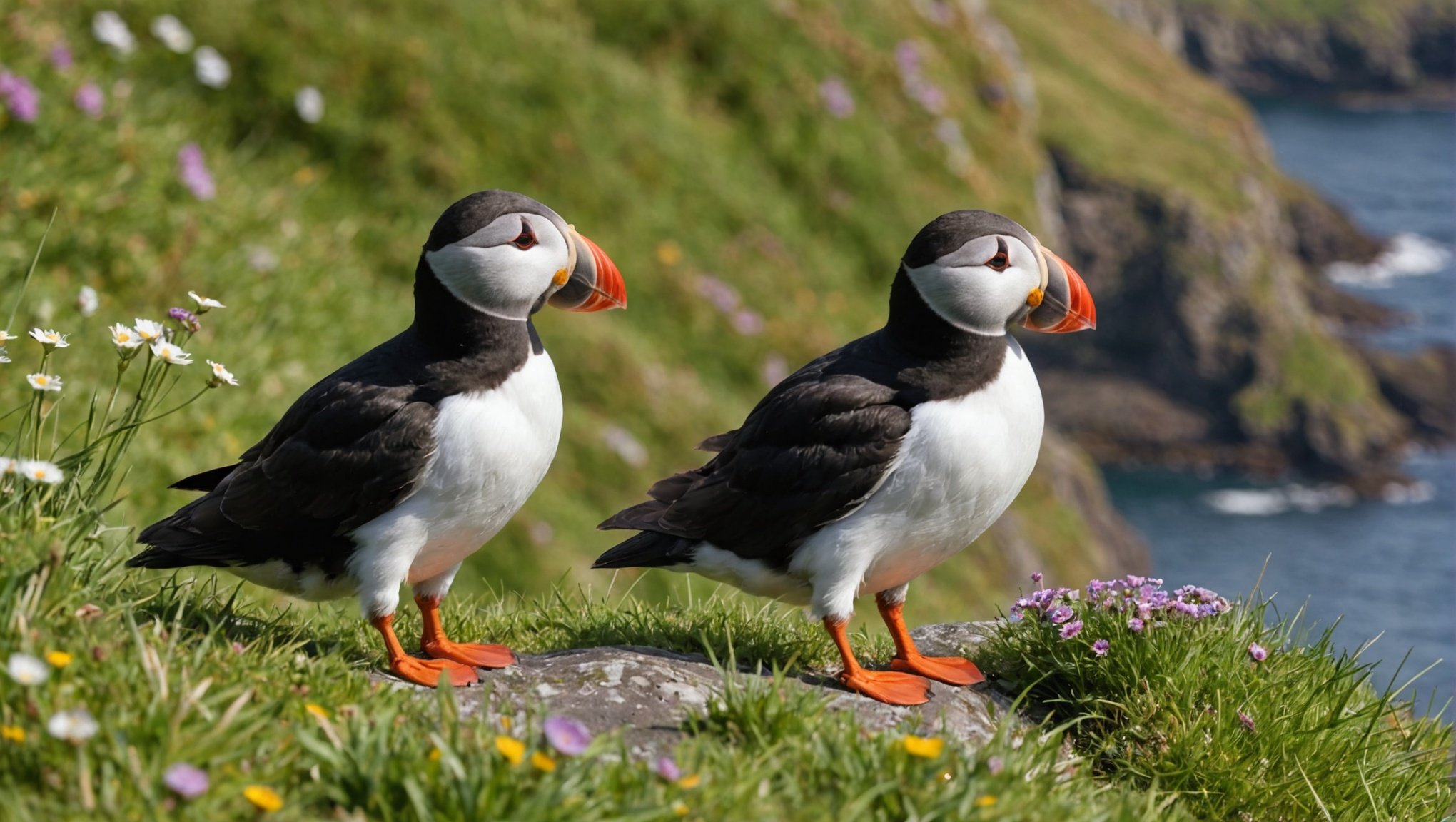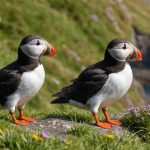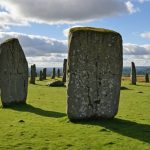Introduction to Puffin Photography in Scotland
Experience the captivating charm of puffin photography on Scotland’s rugged coastlines. Known for their playful demeanor and striking appearance, puffins make delightful subjects for any wildlife photographer. Summer is the ideal time to capture these enchanting birds as they flock to Scotland’s coastal locations for breeding. During these months, the country transforms into a haven for summer wildlife photography, offering an abundant array of opportunities to capture puffins in their natural habitat.
Puffins, with their vibrant beaks and expressive eyes, are not only visually appealing but also provide an insightful glimpse into the rich biodiversity of Scotland’s shores. Scotland coastal locations such as the Isle of Staffa and the Treshnish Isles offer photographers an awe-inspiring backdrop to capture the playful antics of these charismatic creatures.
In the same genre : Discover the Best Locations to Experience a Traditional UK Hog Roast Delight!
Photographing puffins in coastal settings presents numerous benefits. The natural surroundings highlight the birds’ vibrant colours, and the unpredictable Scottish weather adds dynamic elements to images captured amidst ever-changing light conditions. These coastal environments also provide photographers with unique opportunities to experiment with composition while incorporating the breathtaking scenery Scotland is renowned for.
Embrace the adventure and fulfill your summer wildlife photography goals with puffins as your muse, set against the stunning landscapes that only Scotland can offer.
This might interest you : Discover the UK”s Hidden Prehistoric Stone Circles: Unique Guided Tours Beyond Stonehenge
Top Coastal Locations for Puffin Photography
Embracing the rugged beauty of coastal havens, photographers seeking to immortalise puffins have several stunning options. Renowned for their scenery and abundant wildlife, these spots offer a perfect backdrop.
Location 1: Staffa Island
Nestled off Scotland’s west coast, Staffa Island is famed for its eye-catching basalt columns and vibrant puffin colonies. Accessible only by boat, it presents a unique adventure for nature enthusiasts. The island’s geological formations create dramatic settings for photographers, especially during misty mornings. Puffins can be observed up close when they rest on the grassy mounds above the cliffs, providing photographers with tempting opportunities to capture their charm.
Location 2: Bass Rock
Situated in the Firth of Forth, Bass Rock is a colossal volcanic plug hosting thousands of puffins. Known for its sprawling seabird population, this location dazzles with its bustling aviary life. Though access is limited, tours around the base offer incredible angles for capturing the puffins in flight against the backdrop of the North Sea. It’s an ideal location for those keen on both photography and birdwatching.
Location 3: Fair Isle
Fair Isle, lying halfway between Orkney and Shetland, is a beacon for wildlife enthusiasts. Home to a substantial number of seabirds, this isle promises both abundance and serenity. The island’s remote nature appeals to those seeking unique photography opportunities, with unrestricted views of puffins in their natural habitat, mingling amid the vibrant cliffs and clear skies. Accessibility is via a small flight or ferry, offering a peaceful retreat into Scotland’s unspoiled beauty.
Best Times for Puffin Photography
Puffins, with their vibrant colours and unique personalities, attract photographers from around the globe. To achieve stunning shots, understanding their nesting habits is essential. Puffins typically nest on coastal cliff edges, primarily from late spring to early summer, marking the best time to photograph puffins. During this period, they are actively feeding young chicks, providing ample opportunities for capturing dynamic behaviours.
Seasonal migration plays a significant role, as puffins are mainly present on land from May to August before heading back to the sea. For optimal photographs, early morning and late afternoon are ideal times of the day. During these hours, the natural light conditions enhance the colours of these remarkable birds and provide soft, flattering tones.
Weather also influences the quality of outdoor shoots. Gentle, overcast skies are preferable, as they prevent harsh shadows and facilitate even lighting. However, photographers should remain adaptable, as unpredictable weather along coastal areas can abruptly change. Ideal weather conditions ensure not only the safety of equipment but also comfort for photographers, making the experience more enjoyable.
In summary, timing your visit during the nesting season, choosing the right time of day, and planning around favourable weather conditions maximises the chances of capturing memorable puffin photographs.
Recommended Gear for Puffin Photography
Embarking on a puffin photography adventure requires an array of photography gear tailored specifically for capturing these delightful birds.
Essential Camera Equipment
When considering camera equipment for wildlife photography, particularly puffins, a digital SLR or a mirrorless camera with a fast shutter speed is recommended. Canon’s EOS series and Nikon’s D-series are stellar choices, known for their reliability and image quality. Opt for cameras featuring high burst rates to seize those fleeting moments of puffins in flight, ensuring you won’t miss a single detail.
Optimal Lenses for Puffins
The right lenses are pivotal in wildlife photography. A lens with a focal length of 300-500mm is ideal for puffin photography, enabling you to capture sharp images from a safe distance without disrupting their habitat. Zoom lenses also provide versatility in varying distances, offering crisp, detailed shots of puffins in natural settings.
Accessories to Enhance Photography
Accessories like tripods and filters significantly enhance photography experiences. A tripod ensures stability during shooting, crucial for capturing sharp, blur-free images. Polarizing filters can enhance colour and contrast, particularly useful in the glare of coastal settings where puffins reside. Additionally, investing in a durable camera bag will protect your wildlife photography tools, providing portability and convenience during long days in nature.
Photography Techniques for Capturing Puffins
When it comes to puffins, approaching them quietly is paramount. Wildlife photography tips suggest maintaining a safe distance to prevent disturbing these birds. Equip yourself with a zoom lens to avoid getting too near while still capturing detailed images. Move slowly and observe the puffins’ behaviour to understand when they feel comfortable enough for you to take photos.
Composition and framing are essential in wildlife photography. One effective technique is to focus on the puffin’s eyes, ensuring they are sharp and in focus. Use the rule of thirds to position your subject off-centre, creating visual interest and balance in your images. Avoid cluttered backgrounds to keep the viewer’s attention on the bird.
Maximising the use of natural lighting can enhance the quality of your shots significantly. Early mornings or late afternoons offer soft, diffused light, perfect for capturing the vibrant colours of puffin beaks and feathers. Position yourself with the sun at your back to ensure your subject is well-lit. Keep experimenting with exposure levels to manipulate shadows and highlights for more dramatic effects in your photography.
By applying these photography techniques, you’ll be able to capture stunning, respectful images of puffins in their natural habitats.
Travel Guidance and Maps for Coastal Havens
Exploring coastal havens provides photographers with countless opportunities to capture stunning landscapes. Understanding travel routes is key to planning an optimal photography journey. Organising suggested travel itineraries can streamline visits to multiple locations, enabling photographers to make the most of their time. Whether you’re aiming to shoot the golden hour on a secluded beach or capture the vibrant hustle of a coastal town, having a plan is essential.
When considering transportation options, public transportation offers an eco-friendly choice that allows you to appreciate the journey itself. However, driving can offer flexibility, especially when accessing remote or lesser-known spots. With your own vehicle, detours for spontaneous photo ops become feasible, enhancing your overall experience.
For photographers, maps for photography sites are indispensable. Leveraging map resources can help pinpoint potential photography sites and optimise travel routes. Digital navigation tools like Google Maps or specialised apps can offer insight into terrain and light conditions, enhancing your strategic planning. Ensure your navigation tools are updated and reliable to avoid unnecessary detours or obstacles.
Accessing coastal havens is made easier with detailed maps and well-planned routes. Before setting off, it’s beneficial to check for any access restrictions or permits required. Plan efficiently and enjoy the journey through these captivating landscapes.
Personal Anecdotes and Experiences
Capturing the perfect shot during your wildlife photography stories can be an enthralling experience, especially when it involves a puffin encounter. Personal experiences with these charming seabirds often yield lessons that seasoned photographers are keen to share.
One memorable story from a successful puffin trip unfolded on a rugged Scottish island. After hours of waiting, a sudden flurry of activity as puffins returned from sea fishing provided invaluable insights: patience and readiness are crucial. Lingering near their burrows, I noticed how puffins interact, with unique quirks making each photograph singularly special.
From these experiences, several tips have emerged. Firstly, securing great shots involves understanding puffin behaviour. Typically, early mornings or late afternoons when they are most active yields the best results. Secondly, using long lenses is advantageous, minimising disturbance while allowing for detailed close-ups.
These anecdotes illustrate not only the vital importance of preparation but also the delight of witnessing puffins in their natural habitat. For those venturing into the world of puffin photography, remember: it’s beyond just photography; it’s about forming a connection with nature and immortalising those fleeting encounters.
Visual Inspiration and Puffin Images
Embarking on a journey into the world of puffin photography examples can be both thrilling and enlightening. These creatures, with their vibrant beaks and unique personalities, often serve as ideal subjects for aspiring photographers seeking visual inspiration and exploration in capturing wildlife.
Featured Puffin Images
To truly appreciate the charm of puffins, one can explore a variety of photography showcases that highlight their majestic presence. From close-up details of their colourful beaks to breathtaking shots of puffin colonies against dramatic landscapes, these images captivate viewers, offering both novice and seasoned photographers a wealth of visual inspiration.
Inspirational Photography Styles
Exploring diverse photography styles greatly enriches one’s approach to capturing puffins in their natural habitat. Whether opting for a minimalist style that focuses on serene backgrounds and single subjects or dynamic shots filled with movement and vibrant colours, photographers can utilize these styles as powerful visual inspiration.
Engage with the Photography Community
Connecting with the photography community fosters a supportive environment that promotes learning and sharing. Through encounters with fellow enthusiasts, individuals gain access to resources, tips, and puffin photography examples that highlight different approaches. Engaging in forums or local photography groups allows photographers to improve and find visual inspiration from diverse perspectives, enhancing their craft over time.














